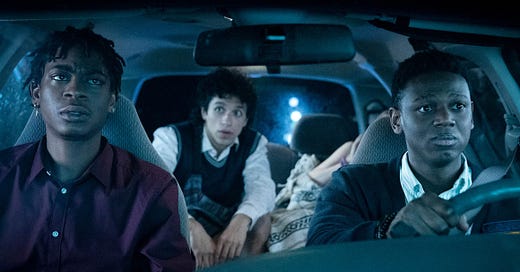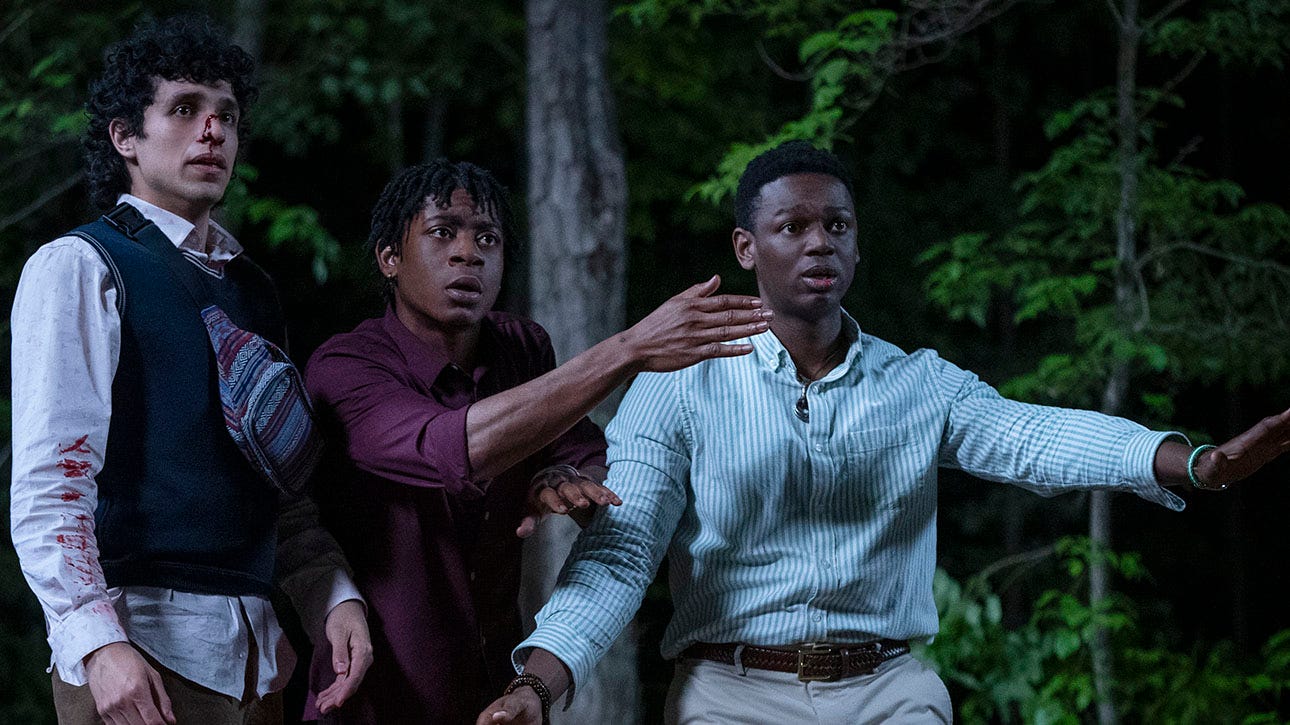What to Watch: "Emergency," "Crimes of the Future"
An intense racial comedy and a visionary's darkest work.
Note to readers: I’ll be taking a breather from the Watch List for the next three weeks and going someplace quiet and beachy with my family. A number of reviews and a podcast are loaded up for delivery during that time, and I may weigh in as events and whims dictate. Otherwise, see you the week of June 27.
The Nut Graf: Three college students share an intense, comic hell-ride through America’s racial anxieties in “Emergency” (streaming on Amazon Prime, *** stars out of ****). “Crimes of the Future” (in theaters, ***1/2 out of ****) is David Cronenberg at his Cronenberg-iest; not for everyone, but darkly witty for those who dare.
The setup is a worst-case-scenario nightmare in its simplicity. Three off-campus roommates find an unknown girl drunk and passed out on their living room floor. She’s white and underage. Two of the roommates, Kunle (Donald Elise Watkins) and Sean (RJ Cyler), are Black, while the third, the puppy-dog goofball Carlos (Sebastian Chacon), is Latino. Kunle, a neatly dressed biology major from suburbia whose parents are both doctors, wants to call 911. Sean, who is not from the suburbs, knows better. After years of viral videos showing the police dispensing summary judgment on people of color, so do we.
“Emergency,” which premiered on Amazon Prime last week after a Sundance berth and brief theatrical run, is one of the smarter entries in the post-“Get Out” cycle of movies that look at Black life in America through the lens of genre filmmaking. It’s a “one crazy night” campus comedy that turns step by crafty step into a suspense thriller, yet it somehow keeps the laughs coming even as they stick in your throat. The second feature film from director Carey Williams – the adroit screenplay is by KD Davila – “Emergency” showcases a young filmmaker who’s growing in assurance even as he still has a few things to learn.
What to do with the unconscious drunk girl? Bad ideas are floated (dump her at the nearest frat party and let someone else deal with it). Sensible ideas are discussed (take her to the hospital). Baroque variations on the sensible ideas are put on the table (find a White person to take her to the hospital). “Emergency” keeps tightening the tension with obstacles around every corner. A taillight that’s out. A police sobriety stop seen two blocks away that’s cause enough for a hard right turn into a quiet suburban neighborhood, “Black Lives Matter” signs on the lawns and residents discreetly videotaping the heroes as they sit in their car figuring out their next move.
As this is going on, Maddie (Sabrina Carpenter), the older sister of the drunk girl (Maddie Nichols), has left the frat party in a panic, dragging two friends on bike and skateboard in a frenzied neighborhood search. Maddie is self-consciously woke, the kind of smart, entitled college kid who says and believes all the right things. She also frets that following her sister’s location on her phone is leading them into “the hood,” and when she sees Kunle and Sean and Carlos loading Sis into their car, she assumes the worst. “Wouldn’t you?” this movie asks its most complacent audiences. Well? Wouldn’t you? “Emergency” holds out a mirror and invites us to look at ourselves; you can choose not to look, but that’s on you. Anyway, the heroes have already assumed a different kind of worst, and with plenty of reason, and the movie leads them toward a reckoning with cold comic logic. No one here “says their names”: Sandra Bland, Philando Castile, Samuel DuBose, and all the rest in the litany. No one here has to.
At the heart of the movie is the angry, affectionate relationship between Kunle and Sean, with an undercurrent of sadness at the thought that straight-arrow Kunle, destined for postgraduate Princeton and better things, is naïve in ways that Sean knows could easily get them killed. Beneath that, tucked under the comedy and angst, is a sense of outrage we’re invited to digest and discuss when the lights come up. I’ve seen some critics scoff at this movie, poking holes in the plot or casting doubt on the entire premise or bristling at the satisfying coda in which Maddie tries to make amends and is politely but firmly reminded that apologies change nothing. That only strikes me as one way to avoid the mirror.
Which isn’t to say that “Emergency” is a perfect movie. The plot climaxes electrifyingly in a scene towards which where all the film’s roads have been leading – after which the lead characters sit around a science department lab and emotionally discuss the events we’ve just witnessed. It’s a rookie mistake, the kind of “tell, don’t show” sequence that drags a story’s subtext up from the basement and turns it into text, the better to let the audience know What Just Happened. Dramatically, structurally, and artistically, the scene isn’t needed. But perhaps there are more pressing concerns here than structure or art. This kind of gambit usually assumes an audience can’t think for itself. In this case, they may not want to.
A few words about “Crimes of the Future,” the new David Cronenberg freakout that opens in New York and L.A. today before going into wider art-house release next week. It’s very much Extreme Cronenberg, taking its place with “Videodrome” (1983) and “Crash” (1996) as the final installment in an unofficial trilogy that dwells on transgression and mutation, “new flesh” and profound kink. Not for your Aunt Minnie, then (I could be wrong; I don’t know your Aunt Minnie), and maybe not for you. There were walkouts at Cannes, and a simple description of the plot could clear the room: In a sepulchral near future, humans have evolved beyond the ability to feel pain, and body modification has become both high art and what bored youths do to amuse themselves on a Saturday night. Viggo Mortensen, looking like Death in “The Seventh Seal,” plays an acclaimed performance artist who grows new organs that are then removed in illegal but well-attended events by his partner and muse (Léa Seydoux). The table, chairs, and beds in this movie all look like unholy medical devices. There’s the dead body of a young boy that figures in the proceedings — his murder in the opening scene announces that this movie will be taking no prisoners — and a man, the boy’s father, who eats strange purple candy bars that no one else can digest. Kristen Stewart, in one of the more fascinatingly weird performances of her career, plays a hopped-up little government official crushing on Mortensen’s character and obsessed with the idea that “surgery is the new sex.”
If you’re reading this and snorting in disbelief, I invite you to consider that Cronenberg is bleakly chortling right along with you. “Crimes of the Future” is, among other things, a pitch-black comedy of dystopia that skewers fatuous high-concept art prats, hypocritical bureaucrats, and pretty much the entire human race with a rigorous and coolly explicit filmmaking scalpel. Mortensen, for one, has never been so slyly funny. But I fear most people will overlook the film’s perverse undercurrent of humor and focus instead on scenes of Mortensen and Seydoux carving each other up in moments of connubial bliss. Like the man said, you always hurt the one you love.
If you enjoyed this edition of Ty Burr’s Watch List, please feel free to share it with friends.
If you’re not a paying subscriber and would like to sign up for additional postings and to join the discussions, here’s how:
If you’re already a paying subscriber, I thank you for your generous support.







